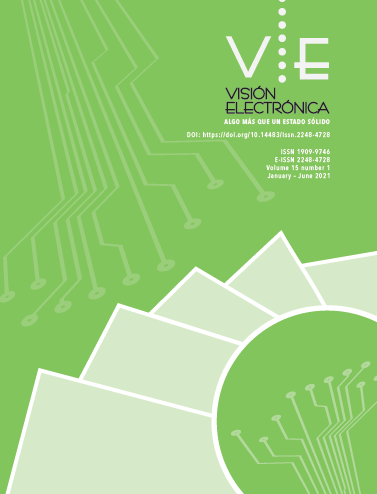DOI:
https://doi.org/10.14483/22484728.17983Publicado:
2021-04-16Número:
Vol. 15 Núm. 1 (2021)Sección:
Visión de CasoReconstrucción 3D de órgano a partir de imágenes de Tomografía Axial Computarizada (TC) usando Matlab
3D Organ Reconstruction from Computed Tomography (CT) Images Using MATLAB
Palabras clave:
Estructura ósea, Interfaz, Riñón, Imágenes médicas, Procesamiento, Segmentación, Reconstrucción (es).Palabras clave:
Bone structure, Interface, Kidney, Medical images, Processing, Segmentation, Reconstruction (en).Descargas
Resumen (es)
El procesamiento tridimensional y la reconstrucción de las regiones anatómicas a partir de imágenes médicas permiten aplicar un conjunto de técnicas de segmentación y filtrado para para realizar posteriormente reconstrucciones volumétricas y así generar representaciones computacionales en 3D de la anatomía humana, que es útil en el campo de la medicina para facilitar análisis de las estructuras del cuerpo humano. En este artículo, se realizó una reconstrucción 3D a partir de la segmentación, basada en la diferenciación por área, del órgano(riñón) y estructuras óseas de una serie de imágenes de un TAC abdominal. También, implementamos una interfaz interactiva para la visualización de los planos (frontal, sagital y transversal). La interfaz que muestra los diferentes planos y también carga la reconstrucción 3D que se generó en un proceso aparte, da la opción al usuario de seleccionar cualquier estudio TAC que tenga almacenado en su ordenador. Este procedimiento, según el campo de aplicación, complementa la interacción y análisis de estructuras anatómicas al médico, permite planificar un tratamiento oportuno que ayudará al análisis preoperatorio de patologías complejas y la formulación de estrategias quirúrgicas.
Resumen (en)
The three-dimensional processing and reconstruction of anatomical regions from medical images allows the application of a set of segmentation and filtering techniques to subsequently perform volumetric reconstructions and thus generate 3D computer representations of human anatomy, which is useful in the field of medicine to facilitate the analysis of human body structures. In this paper, a 3D reconstruction was performed from the segmentation, based on the differentiation by area, of the organ (kidney) and bone structures from a series of images from an abdominal CT. Also, we implemented an interactive interface for the visualization of the planes (frontal, sagittal and transversal). The interface that shows the different planes and also loads the 3D reconstruction that was generated in a separate process, gives the user the option to select any CT study that he has stored in his computer. This procedure, depending on the field of application, complements the interaction and analysis of anatomical structures to the physician, allowing the planning of a timely treatment that will help the preoperative analysis of complex pathologies and the formulation of surgical strategies.
Referencias
R. N. Strickland, “Image-Processing Techniques for Tumor Detection”, Boca Raton, Florida: CRC Press, 2002. https://doi.org/10.1201/9780203909355
J. Thirumaran, S. Shylaja, “Medical Image Processing - An Introduction”, International Journal of Science and Research (IJSR), vol. 4, no. 11, pp. 1197-1199, 2015. https://doi.org/10.21275/v4i11.NOV151288
F. Ballester, J. M. Udías, “Física Nuclear y Medicina”, Rev. Esp. Fís., vol. 22, no. 1, pp. 29-36, 2008.
P. Mildenberger, M. Eichelberg, E. Martin, “Introduction to the DICOM standard”, European Radiology, vol. 12, pp. 920-927, 2002. https://doi.org/10.1007/s003300101100
C. E. J. Kahn, J. A. Carrino, M. J. Flynn, D. J. Peck, S. C. Horii, “DICOM and Radiology: Past, Present, and Future”, TECHNOLOGY TALK, vol. 4, no. 9, pp. 652-657, 2007. https://doi.org/10.1016/j.jacr.2007.06.004
A. P. Bhagat, M. Atique, “Medical images: Formats, compression techniques and DICOM image retrieval a survey”, International Conference on Devices, Circuits and Systems (ICDCS), pp. 172-176, 2012. https://doi.org/10.1109/ICDCSyst.2012.6188698
D. P. Hanson, R. A. Robb, “Chapter 45 - Three-Dimensional Visualization in Medicine and Biology”, Second Edition, pp. 755-784, 2009. https://doi.org/10.1016/B978-012373904-9.50056-8
El Hospital, Reconstrucción 3D de la anatomía humana a partir de imágenes médicas obtenidas por ayuda diagnóstica, 2016. [Online]. Available at: https://www.elhospital.com/blogs/Reconstruccion-3D-de-la-anatomia-humana-a-partir-de-imagenes-medicas-obtenidas-por-ayuda-diagnostica+116633
J. M. Selman, “Aplicaciones clínicas del procesamiento digital”, Revista Médica Clínica Las Condes, vol. 15, no. 2, 2004.
M. Solaiyappan, “Chapter 44 - Visualization Pathways in Biomedicine”, Second Edition, pp. 729-753, 2009. https://doi.org/10.1016/B978-012373904-9.50055-6
J. Rogowska, “Chapter 5 - Overview and Fundamentals of Medical Image Segmentation”, Second Edition, pp. 73-90, 2009. https://doi.org/10.1016/B978-012373904-9.50013-1
R. Jiménez Moreno, O. Avilés, D. M. Ovalle, “Red neuronal convolucional para discriminar herramientas en robótica asistencial”, Visión Electrónica, vol. 12, no. 2, pp. 208–214, 2018. https://doi.org/10.14483/22484728.13996
DICOM Library & medDream, “Dicom Library (Modality CT)”, 2011. [Online]. Available at: https://www.dicomlibrary.com/
Cómo citar
APA
ACM
ACS
ABNT
Chicago
Harvard
IEEE
MLA
Turabian
Vancouver
Descargar cita
Licencia
Derechos de autor 2021 Visión electrónica

Esta obra está bajo una licencia internacional Creative Commons Atribución-NoComercial 4.0.
.png)
atribución- no comercial 4.0 International






.jpg)





